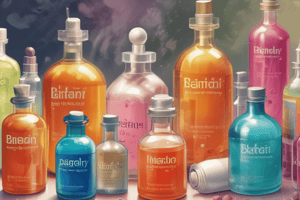Podcast
Questions and Answers
What is the term used for the mixture of acute and inert ingredients in a pesticide?
What is the term used for the mixture of acute and inert ingredients in a pesticide?
Formulation
Which of the following are advantages of using emulsifiable concentrates (EC)? (Select all that apply)
Which of the following are advantages of using emulsifiable concentrates (EC)? (Select all that apply)
- Leave little visible residue on treated surfaces (correct)
- Easy to handle, transport, store, pour, and measure (correct)
- Strong odor
- Easily absorbed through skin
- Little agitation required (correct)
- Corrosive to application equipment
- May damage treated surfaces
Which of the following are advantages of using wettable powders (WP)? (Select all that apply)
Which of the following are advantages of using wettable powders (WP)? (Select all that apply)
- Abrasive to pumps and nozzles
- Inhalation hazard
- Easy to store, transport, handle (correct)
- Less likely to harm treated plants, animals, and surfaces (correct)
- Must be weighed
- Easy to mix
- Not phytotoxic (correct)
Which of the following are advantages of using flowables (F or AF)? (Select all that apply)
Which of the following are advantages of using flowables (F or AF)? (Select all that apply)
Which of the following are advantages of using ready-to-use or predicted sprays? (Select all that apply)
Which of the following are advantages of using ready-to-use or predicted sprays? (Select all that apply)
Which of the following are advantages of using pastes, gels, and other injectable baits? (Select all that apply)
Which of the following are advantages of using pastes, gels, and other injectable baits? (Select all that apply)
Which of the following are advantages of using dusts? (Select all that apply)
Which of the following are advantages of using dusts? (Select all that apply)
Which of the following are advantages of using solid baits? (Select all that apply)
Which of the following are advantages of using solid baits? (Select all that apply)
What is the primary function of inert ingredients in a pesticide formulation?
What is the primary function of inert ingredients in a pesticide formulation?
What are the two main types of respirators used to protect against pesticide exposure, and what makes them different?
What are the two main types of respirators used to protect against pesticide exposure, and what makes them different?
Flashcards
Halogens
Halogens
Powerful oxidizing agents that kill by "burning" the cell membranes of microorganisms such as molds and bacteria.
Quaternary Ammonium (Quats)
Quaternary Ammonium (Quats)
Used on surfaces to kill microorganisms, including molds.
Phenolics
Phenolics
Used to treat equipment and surfaces to kill molds.
Formulation
Formulation
Signup and view all the flashcards
Inert Ingredients
Inert Ingredients
Signup and view all the flashcards
Different Types of Formulations
Different Types of Formulations
Signup and view all the flashcards
Emulsifiable Concentrates (EC)
Emulsifiable Concentrates (EC)
Signup and view all the flashcards
Wettable Powders (WP)
Wettable Powders (WP)
Signup and view all the flashcards
Flowables (F or AF)
Flowables (F or AF)
Signup and view all the flashcards
Ready-to-Use or Premixed Sprays
Ready-to-Use or Premixed Sprays
Signup and view all the flashcards
Pastes, Gels, and Other Injectable Baits
Pastes, Gels, and Other Injectable Baits
Signup and view all the flashcards
Dusts
Dusts
Signup and view all the flashcards
Solid Baits
Solid Baits
Signup and view all the flashcards
Pesticide Label
Pesticide Label
Signup and view all the flashcards
Label
Label
Signup and view all the flashcards
Labeling
Labeling
Signup and view all the flashcards
Signal Word
Signal Word
Signup and view all the flashcards
Risk
Risk
Signup and view all the flashcards
Toxicity
Toxicity
Signup and view all the flashcards
Exposure
Exposure
Signup and view all the flashcards
Local Effects of Pesticides
Local Effects of Pesticides
Signup and view all the flashcards
Systemic Effects of Pesticides
Systemic Effects of Pesticides
Signup and view all the flashcards
LD50
LD50
Signup and view all the flashcards
LC50
LC50
Signup and view all the flashcards
Toxicity Categories and Signal Words
Toxicity Categories and Signal Words
Signup and view all the flashcards
Personal Protective Equipment (PPE)
Personal Protective Equipment (PPE)
Signup and view all the flashcards
Hazard Communications Standard (HCS)
Hazard Communications Standard (HCS)
Signup and view all the flashcards
Calibration
Calibration
Signup and view all the flashcards
Overspray
Overspray
Signup and view all the flashcards
Drift
Drift
Signup and view all the flashcards
Solubility
Solubility
Signup and view all the flashcards
Adsorption
Adsorption
Signup and view all the flashcards
Volatility
Volatility
Signup and view all the flashcards
Persistence
Persistence
Signup and view all the flashcards
Degradation
Degradation
Signup and view all the flashcards
Bioaccumulation
Bioaccumulation
Signup and view all the flashcards
Biomagnification
Biomagnification
Signup and view all the flashcards
Point Source Pollution
Point Source Pollution
Signup and view all the flashcards
Non-Point Source Pollution
Non-Point Source Pollution
Signup and view all the flashcards
Study Notes
Mold Remediation Products
- Halogens kill microorganisms by burning cell membranes
- Quaternary ammonium compounds (quats) are used on surfaces
- Phenolics are used to treat equipment and surfaces
Formulation Definition
- A formulation is a mixture of active and inert ingredients
- Inert ingredients don't have pesticidal activity
- They improve application effectiveness, safety, handling, storage, or other characteristics of the final product
Different Formulations
- Pesticides come in various formulations for specialized use
- Consider intended use, application equipment, target area, surface damage potential, and effectiveness
- Examples:
- Emulsifiable concentrates (EC): easy to handle, transport, and measure; little agitation required; high concentration of active ingredients; may easily overdose; can damage surfaces; strong odor; corrosive to equipment; flammable
- Wettable powders (WP): easy to store, transport, handle; less likely to harm plants, animals, and surfaces; not phytotoxic; less risk of skin and eye absorption; must be weighed; need good agitation; abrasive to pumps and nozzles
Health Concerns Associated with Different Formulations
- Using poisonous baits: advantages: odorless, long-lasting, low exposure; disadvantages: attracts non-target animals
- Identify the Federal Insecticide, Fungicide, and Rodenticide Act (FIFRA) and the Environmental Protection Agency (EPA) as the agencies governing pesticide registration
- EPA is responsible for registering pesticide products in the US
- State and federal laws related to pesticide use might differ, with state laws sometimes being more strict than federal laws
Pesticide Application Records
- Applicators must keep pesticide application records for at least two years
- The records must include contact information, product description, application date, approximate time ranges, quantity used, each pesticide application location, and mixed/loaded location
- Transporting pesticides: receive training, carry emergency response info, carry shipping papers, and placard the vehicle
Legal Implications of Pesticide Use
- Labels and SDS sheets are legally binding documents
- List 5 times to read pesticide labels
- Types of info you can find on a pesticide label: restricted use statement, trade name, EPA registration, ingredients/contents, safety info, signal words
- Signal words: danger-poison, danger, warning, caution, and their relation to toxicity levels
Pesticide Exposure and Response
- Causes of pesticide exposure - handling dusts, working with spray or dust drift, contact with containers
- Symptoms of pesticide exposure - describe symptoms based on mode and location of exposure (dermal, inhalation, ingestion, eye)
- Actions to take upon exposure - medical attention, check label, call poison control, first aid measures (dermal, inhalation, eye)
Pesticide Storage and Disposal
- Designate a separate space for pesticide storage; keep away from residential areas, and keep away from wells
- Follow label directions to secure and store hazardous materials; comply with all local, state, and federal laws regarding disposal
- Improper storage of chemicals can contribute to contamination of the environment
Pesticide Spill, Containment, and Management
- Designate spill response procedures
- Recognize the need to contain the spill before cleaning
- Contact local emergency agencies in the event of a spill
Pesticide Resistance
- Pesticide resistance arises in pest populations when individuals with resistance survive pesticide applications
- Factors influencing resistance in populations:
- Resistance frequency before use
- Pesticide mode of action
- Pesticide persistence and frequency of use
- Proportion of the population exposed to the pesticide
- Pest life cycle
- IPM practices to manage resistance include the use of pesticides only as needed and rotate pesticides with different modes of action
Pesticide Use in Residential Areas
- Provide notice of residential and non-residential applications of pesticides
- Understand the rules for regulated properties
Studying That Suits You
Use AI to generate personalized quizzes and flashcards to suit your learning preferences.




